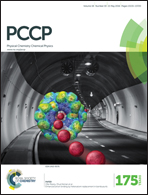Energetics of nonpolar and polar compounds in cationic, anionic, and nonionic micelles studied by all-atom molecular dynamics simulation combined with a theory of solutions
Abstract
Energetic analysis was conducted for nonpolar and polar solutes bound in a cationic micelle of dodecyl trimethyl ammonium bromide (DTAB), an anionic micelle of sodium dodecyl sulfate (SDS), and a nonionic micelle of tetraethylene glycol monododecyl ether (Brij30). All-atom molecular dynamics simulation was performed, and the free energies of binding the solutes in the hydrophobic-core and headgroup regions of the micelles were computed using the energy-representation method. It was found in all the micelles examined that aromatic naphthalene is preferably located more outward than aliphatic propane and that the polar solutes are localized at the interface of the hydrophobic and hydrophilic regions. The roles of the surfactant and water were then elucidated by decomposing the free energy into the contributions from the respective species. Water was observed to play a decisive role in determining the binding location of the solute, while the surfactant was found to be more important for the overall stabilization of the solute within the micelle. The effects of attractive and repulsive interactions of the solute with the surfactant and water were further examined, and their competition was analyzed in connection with the preferable location of the solute in the micellar system.


 Please wait while we load your content...
Please wait while we load your content...